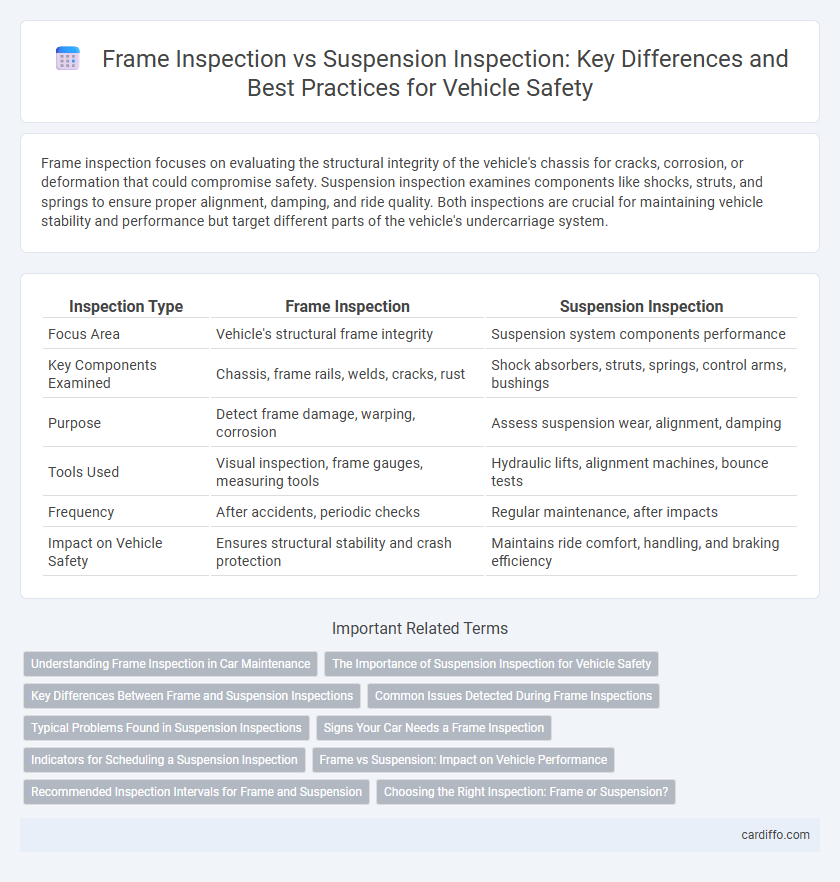Frame inspection focuses on evaluating the structural integrity of the vehicle's chassis for cracks, corrosion, or deformation that could compromise safety. Suspension inspection examines components like shocks, struts, and springs to ensure proper alignment, damping, and ride quality. Both inspections are crucial for maintaining vehicle stability and performance but target different parts of the vehicle's undercarriage system.
Table of Comparison
| Inspection Type | Frame Inspection | Suspension Inspection |
|---|---|---|
| Focus Area | Vehicle's structural frame integrity | Suspension system components performance |
| Key Components Examined | Chassis, frame rails, welds, cracks, rust | Shock absorbers, struts, springs, control arms, bushings |
| Purpose | Detect frame damage, warping, corrosion | Assess suspension wear, alignment, damping |
| Tools Used | Visual inspection, frame gauges, measuring tools | Hydraulic lifts, alignment machines, bounce tests |
| Frequency | After accidents, periodic checks | Regular maintenance, after impacts |
| Impact on Vehicle Safety | Ensures structural stability and crash protection | Maintains ride comfort, handling, and braking efficiency |
Understanding Frame Inspection in Car Maintenance
Frame inspection in car maintenance involves a thorough assessment of the vehicle's structural integrity, identifying any cracks, rust, or damage that could compromise safety. Unlike suspension inspection, which focuses on components like shocks, struts, and control arms affecting ride quality and handling, frame inspection ensures the core chassis remains sound and free from warping or misalignment. Regular frame inspections are critical for detecting hidden damage from accidents or corrosion that might lead to costly repairs or unsafe driving conditions.
The Importance of Suspension Inspection for Vehicle Safety
Suspension inspection plays a critical role in vehicle safety by ensuring proper alignment, stability, and shock absorption while driving. Unlike frame inspection, which focuses on the structural integrity of the vehicle chassis, suspension inspection evaluates components such as shock absorbers, struts, springs, and control arms that directly impact ride comfort and handling. Regular suspension inspections help prevent uneven tire wear, improve braking efficiency, and reduce the risk of accidents caused by compromised steering and control.
Key Differences Between Frame and Suspension Inspections
Frame inspection focuses on assessing the vehicle's structural integrity, checking for cracks, bends, rust, or alignment issues that could compromise safety. Suspension inspection evaluates components such as shocks, struts, springs, and control arms for wear, damage, and proper function to ensure ride stability and handling performance. Key differences between frame and suspension inspections include the scope of evaluation--structural versus functional parts--and the impact on vehicle safety versus ride comfort.
Common Issues Detected During Frame Inspections
Frame inspections commonly reveal issues such as cracks, rust, and alignment problems that compromise vehicle safety and structural integrity. Detecting corrosion and metal fatigue early prevents costly repairs and potential frame failure. These inspections differ from suspension checks, which focus more on components like shocks, struts, and bushings rather than structural damage.
Typical Problems Found in Suspension Inspections
Suspension inspections commonly reveal issues such as worn-out bushings, leaking shock absorbers, and damaged control arms, which directly affect vehicle stability and safety. Unlike frame inspections that target structural integrity and corrosion, suspension inspections focus on mechanical components that impact ride quality and handling performance. Identifying typical problems early in suspension components like ball joints or struts prevents uneven tire wear and potential steering failures.
Signs Your Car Needs a Frame Inspection
Visible cracks, rust spots, or bent areas on the vehicle's chassis indicate the need for a frame inspection to ensure structural integrity. Uneven tire wear, misaligned steering, or difficulty maintaining direction often signal frame damage that requires professional evaluation. Frame inspections are crucial after collisions or off-road use to detect hidden issues that suspension inspections alone may not reveal.
Indicators for Scheduling a Suspension Inspection
Visible cracks, unusual noises during driving, and uneven tire wear are key indicators signaling the need for a suspension inspection. Unlike frame inspections that focus primarily on structural integrity and alignment issues, suspension inspections prioritize components such as shocks, struts, and bushings for wear or damage. Regular suspension inspections help maintain vehicle stability, ensuring safety and optimal handling performance.
Frame vs Suspension: Impact on Vehicle Performance
Frame inspection ensures the vehicle's structural integrity, preventing misalignment and potential safety hazards that directly affect handling and durability. Suspension inspection focuses on components like shocks, struts, and springs, which influence ride comfort, stability, and tire wear. Both frame and suspension maintenance are critical for optimal vehicle performance, with frame issues affecting core stability and suspension problems impacting dynamic control and comfort.
Recommended Inspection Intervals for Frame and Suspension
Recommended inspection intervals for frame components typically range from every 12,000 to 15,000 miles or annually, depending on vehicle usage and environmental conditions. Suspension inspections should be conducted at similar intervals, with emphasis on critical components such as shocks, struts, and bushings, often recommended every 10,000 to 15,000 miles. Timely inspections help identify wear, corrosion, and structural damage, ensuring vehicle safety and performance.
Choosing the Right Inspection: Frame or Suspension?
Selecting the appropriate inspection between frame and suspension is crucial for vehicle safety and longevity. Frame inspections focus on detecting structural damage, corrosion, and alignment issues affecting the vehicle's chassis integrity, while suspension inspections assess components like shocks, struts, springs, and control arms for wear or failure impacting ride quality and handling. An expert evaluation prioritizes frame inspection if the vehicle has experienced accidents or rust exposure, whereas suspension inspection is essential for diagnosing handling problems or uneven tire wear.
Frame inspection vs suspension inspection Infographic

 cardiffo.com
cardiffo.com